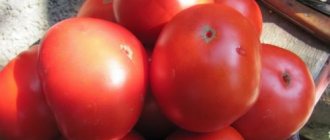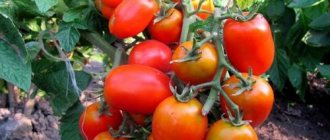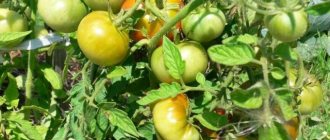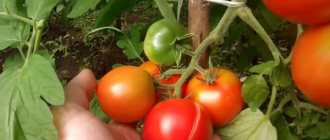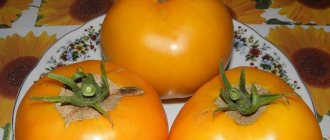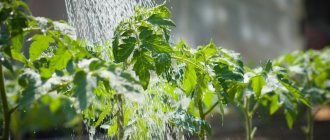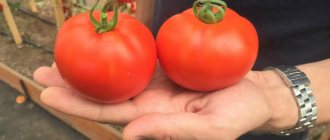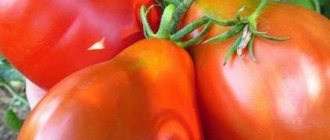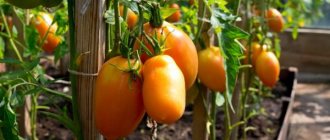The name of the famous variety is consonant with the name of the star of the southern hemisphere, a bright giant that illuminates the night sky with a fabulous brilliance. Like its “cosmic namesake,” the Canopus tomato is a guiding star in the “garden universe” of experienced summer residents. Even novice gardeners can cope with growing this unpretentious tomato variety!
People who have already been lucky enough to plant hybrid tomato seeds note not only its excellent taste characteristics, but also its ease of care. Canopus tomatoes need minimal amounts of mineral fertilizers, regular watering with warm water and sunlight.
Benefits of Canopus tomatoes
Those who have already planted plasma seeds of a variety popular among gardeners focus on the following advantages:
- large size of the fruit;
- juiciness of already ripe tomatoes;
- high taste compatibility with other products;
- possibility of conservation, processing;
- simple care procedures;
- resistance to long-term absence of water;
- normal perception of adverse weather conditions.
In addition, the description of the Canopus tomato contains another clear advantage of the variety - endurance, resistance to diseases, including:
- Late blight, which annually destroys millions of hectares of crops. Universal symptoms are the appearance of gray-brown spots on the leaves that look like mold. The fruits and stems of the plant are also susceptible to the disease.
- Tobacco mosaic virus is a rod-shaped RNA virus that stains fruits and leaves with yellowish spots. The bizarre patterns of the disastrous mosaic provoke deprivation of their presentation, the previously red tomatoes become spotted, and the taste deteriorates.
- Bacterial spotting, destroying vegetation with rusty spots, unaesthetic spots on the greenish layers of leaves, rounded borders of an appetizing fruit.
Canopus tomatoes are resistant to these diseases; the rich yield of the variety will not be threatened due to the bacterial attack of parasitic diseases.
With proper care, the harvest will surprise you with the abundance of red fruits, their colorful visual characteristics, and taste qualities worthy of the best dishes of elite restaurants.
Advantages and disadvantages
Most gardeners highly appreciate the following positive characteristics:
- High yield of bushes.
- Possibly large fruit sizes.
- Easy to grow, including good fruit set in conditions of insufficient moisture.
- Resistance to a wide range of diseases and other adverse factors.
- Presentation of tomatoes, possibility of long-term storage and transportation.
We cannot ignore the possible disadvantages of Canopus tomatoes:
- Not the best taste and aroma of tomatoes - most gardeners use them mainly for processing.
Growing seedlings of their seeds
Seeds are placed in ready-made or home-made boxes with soil for tomatoes, in holes to a depth of 3-5 mm. It is recommended to pre-treat the entire seed fund with a weak solution of potassium permanganate or hydrogen peroxide. This will improve the immunity of future seedlings and disinfect the seedlings from fungal or bacterial infections.
Then the planted seeds are covered with thick paper sprayed with water from a spray bottle. After the bushes germinate, they need to be watered with warm water and fed with microfertilizers. When 2-3 leaves appear on the sprouts, the plants dive. The seedlings are planted on permanent soil after 50-60 days. Before this, it is recommended to harden the seedlings for a week.
The bushes are planted in the ground, where nitrogen and organic fertilizers are added. The planting pattern is standard - 0.5x0.5 m. To get an early harvest, the farmer can remove the shoots. This operation allows you to increase the weight of fruits when growing them in a greenhouse. For open ground it is not necessary.
The stems are tied to supports or trellises, otherwise, when large fruits develop, the tomato branches may break off.
This is interesting: The Chinese method of growing tomato seedlings - we describe it in detail
Harvesting and application
Since the tomato is mid-season, ripening occurs towards the end of summer. The main thing is to ensure that the fruits do not overripe, otherwise, being heavy, they can break the bushes. If, due to the large volume grown, the bushes are not tied up, the tomatoes are collected from the surface of the ground. In this case, it is also necessary to monitor the ripeness, otherwise they will crack and rot from overripeness.
The fruits are distinguished by excellent presentation, long storage and good transportability. However, this is not surprising, given that this particular species is preferred as a crop that generates income through sale.
These vegetables are also versatile in cooking – they are good both fresh and in preparations for the winter.
Description of the variety
Tomato “Pink Treasure F1” is a first generation hybrid variety. A determinate bush when grown in greenhouses can reach a height of 1.5 meters. In open ground, tomatoes grow more compact and shorter.
IMPORTANT: To improve the yield of tomatoes, it is recommended to plant seedlings.
Main characteristics of the fruit of the variety:
- Large, flat-round tomatoes;
- The stalk has noticeable ribbing;
- Unripe tomatoes are light green in color;
- Ripe fruits change color - it becomes raspberry-pink;
- The pulp is dense, juicy and fleshy;
- The fruit produces a small number of seeds;
- The taste is rich, sweet, without sourness;
- High content of vitamins and minerals;
- Average weight is about 600 grams.
REFERENCE: The largest fruits ripen on the lower branches of the tomato. Their weight can reach 1.5 kg.
Due to their high sugar and beta-carotene content, Pink Treasure F1 tomatoes are recommended for making baby food.
Typical mistakes when growing
This variety is resistant to drought, cold and weather changes, but it is not shade-loving.
It would be a mistake to plant it in a poorly lit area - tomatoes often become smaller and become sour. In addition, lack of light negatively affects the overall yield.
In such cases, tomatoes spoil, are damaged by insects, and provoke diseases. The easiest way to avoid mistakes is to put supports under heavy branches or fruit clusters.
https://youtube.com/watch?v=-S922eu9myc
This variety of tomato got its name from a star from the Southern Hemisphere. Canopus is a yellowish-white star, a supergiant in the sky, captivating with magical light, and in the garden there is a special variety of tomatoes that organically combines excellent taste with ease of care.
The Canopus tomato comes from Siberia (from Novosibirsk), so it is quite suitable for the difficult conditions of the Siberian summer and other regions that differ little in climatic conditions. However, it also takes root well in greenhouses. It is classified as determinant because it has limited growth.
Description and photos of the best hybrids
For open ground, breeders also offer species with high yields of hybrid origin; they are resistant to diseases and temperature changes. The best tomato varieties of 2020:
- Intuition F1 is one of the best tomato hybrids for picking with trusses, mid-season, from germination to harvesting the first vegetables - 110 days.
- Katya F1 is an early ripening hybrid. The fruits weigh 90-130 g and ripen simultaneously. From 1 m² you can harvest more than 10 kg of fruit per season.
- Search F1 – unpretentious and at the same time tasty tomatoes. The hybrid withstands cold weather and is immune to most diseases. The bushes are strewn with small red fruits, which are excellent for pickling and canning.
- Blagovest F1 is an early-ripening hybrid. The fruits are round, glossy, with slightly pronounced ribbing. From one bush you can collect up to 5 kg of fruit.
- La la fa F1 - has excellent consumer qualities, high yield and unpretentiousness. The average weight of the fruit is 140-170 g. From 1 m² you can harvest up to 20 kg.
- Vladimir F1 - has a high yield and is suitable for cultivation in any type of soil. High productivity throughout the entire fruiting period.
- Beef King F1 is an early maturing Dutch hybrid. The tomatoes are round, dense, smooth. From one bush you can collect up to 4-5 kg. Resistant to low temperatures and diseases.
- Ashdod F1 – tomatoes with smooth, dense skin. Fruit weight is from 110 to 140 g. The pulp has a bright burgundy color.
- Tanya F1 is a hybrid from the Netherlands with excellent immunity, dense structure, and good yield. The fruits have a regular round shape, weighing 150-200 g. They tolerate transportation well.
If the designation on a bag of planting material is F1 – hybrids of tomatoes (or other plants) of the first generation, F2 – of the second, and so on.
Exceptional taste, fruit weight, constant yield, disease resistance, adaptation to weather conditions are the advantages of hybrids over tomato varieties.
Overview of determinate tomatoes
All determinate tomatoes are best grown in the garden. With the greenhouse method of growing tomatoes, a minimum of space is allocated for low-growing varieties. It is easy to care for the crop; it is not tied to a trellis; instead of a stepson, only the shoots located below the first ovary are pinched. Determinate tomatoes are characterized by a friendly and early harvest.
Upstart
Tomatoes ripen together on several bunches at once. The vegetable is considered mature after 100 days. The variety is characterized by good yield in open areas. When planting early, the plant can be covered with film. The bushes grow up to 1 m in height, sometimes requiring support from wooden stakes. A tomato with red tender pulp weighs up to 100 g.
Arctic
A compact plant with a stem height of only 40 cm will bear delicious early tomatoes in 80 days. The culture does without removing shoots, regular watering and fertilizing the soil. The variety can be called decorative because of its small, beautiful red tomatoes. The tomato is more suitable for home growing.
City dweller F1
The variety of small-fruited tomato is loved by summer residents because of the excellent taste of the fruit. Moreover, the vegetable ripens very early. The plant bears fruit well in any conditions, so it is often grown in flower pots on a windowsill, balcony or terrace. Culture has a little secret. Pinching lateral shoots can significantly increase yield. Small spherical tomatoes weigh only 30 g.
Paradise F1
The ripening of the first fruits is observed after 100 days. The hybrid is considered early, capable of growing on any type of soil, while bringing a large harvest. Elongated tomatoes weigh about 120 g. There is a small green spot around the stalk. This tasty vegetable is great for pickling and salads.
Crane
The crop is considered medium-early in terms of ripening time. The main stem of the plant can stretch up to 1 m in height. The red, elongated tomatoes are held quite firmly on the stalk. With its neat shape and weight of 120 g, the vegetable is suitable for canning and pickling.
We looked at productive tomato varieties that bear tasty fruits for various purposes, which were tested in cultivation by experienced vegetable growers and hobbyists. Each of these crops can be successfully grown in your home garden.
Growing
Tomato The effect is mid-season, the yield is not very high, about 5 kg/m2, but this is typical for tasty salad varieties. The plant spends all its energy to produce juicy tomatoes, losing slightly in yield to other less tasty varieties for canning. Fruiting is reliable and stable until the onset of cold weather.
Seedling
In mid-March, seedlings are sown. The soil mixture is prepared nutritious and loose.
It is best to take garden soil from the future garden bed as a basis.
This will make it easier for the seedlings to adapt after transplantation. You need to add organic components to the soil: compost, humus. For looseness and lightness, add a little sawdust, peat and sand.
Sawdust should always be steamed with boiling water before use.
The soil is brought into a warm place at least a day before sowing the seedlings and watered with boiling water.
Seeds are planted to a depth of 10 mm at a distance of 2-3 cm from each other. The boxes are covered with film and placed in a warm place. The optimal germination temperature for tomato seeds is 24-25 ℃. When the shoots appear, the film is removed and the temperature must be reduced to 20-21 ℃. Tomatoes The effect is ensured by illumination with fluorescent lamps for 2-3 evening hours so that the sprouts do not stretch out.
After 1-2 true leaves appear, the tomatoes dive.
If space allows, it is better to transplant each sprout into a separate pot with a volume of 2-3 liters.
This will allow the plant to develop a normal root system and make it easier to transplant to the beds. Water the tomatoes moderately, allowing the soil to dry sufficiently, but not allowing the sprouts to wilt. Seedlings are fed 1-2 times with complex mineral fertilizers or mullein infusion.
Hardening of seedlings
If the weather is good and the temperature rises to 20-24 ℃ during the day, then at the age of 5 weeks the seedlings can begin to harden. First, the plants are taken out for 30-40 minutes during the warmest hours, shaded from direct sunlight. Every day the time is increased by 1-2 hours. During the second week, the seedlings are accustomed to direct sunlight. Temperatures below 14-15 ℃ are undesirable for tomatoes; during cold weather, you can simply arrange long-term ventilation.
If the weather permits, during the third week of hardening the plants are left outside around the clock. Depending on the region, transplanting seedlings is possible from mid-May to early June, at the age of 60-65 days.
Effect tomatoes belong to the determinant type of growth, so they do not need a garter. The height of plants usually does not exceed 65-80 cm. No more than 3-4 plants are planted per 1 m2. It is useful to mulch the soil with sawdust or peat; this will eliminate the need for frequent loosening.
Water the tomatoes sparingly, allowing the top layer of soil to dry. This will give the plant a signal to develop the root system and not overgrow the green mass to the detriment of yield. Increase watering only when fruit is filling.
Feed the Effect tomato variety 3-4 times, if possible alternating complex mineral and organic fertilizers.
Landing
Seeds are planted in seedlings. The timing of sowing seedlings is 55-60 days before transferring the bushes to the ground. The growing algorithm is as follows:
- Calibrate the seeds (choose the largest and healthiest ones).
- They are checked for germination by throwing them into a glass of water. Those that float on the surface will most likely not emerge.
- Soak in a one percent solution of potassium permanganate for an hour.
- Wash and, if desired, treat with a stimulant - Zircon or Epin (or another drug) according to the instructions.
- The soil is mixed from garden soil, peat, sand and humus, then disinfected with a boiling solution of potassium permanganate or copper sulfate.
- In the soil laid out in large boxes, make grooves 1-1.5 cm deep and place seeds in them at small intervals.
- Cover with soil, moisten and cover with film.
- The first few days before germination are kept in a warm room at +25 or even more.
- After the sprouts appear, remove the film and move it to a sunny place.
- The temperature in the first 3 days is kept at +14, then raised to +18-22.
- They provide a sunny day of at least 8 hours, and if there is a lack of lighting, use fluorescent lamps.
- Picking is carried out in separate peat cups in the 2-leaf phase.
- Before transplanting into the garden, the seedlings are hardened off by taking them outside for a while every day.
If necessary, seedlings can be fed 1-2 times with special fertilizer.
The best predecessors for tomatoes in the garden are zucchini, cucumbers, and pumpkin. It is impossible to plant after nightshade crops.
For 1 sq. m place 4 plants.
Growing and care
In open ground, the variety does not require pinching. They are tied as necessary so that the bushes do not break from the weight of the fruit. In the greenhouse, plants are led into 2 stems and tied.
Although the variety tolerates drought, it benefits from moderate watering. Tomatoes are watered once a week, being careful not to over-moisten the soil and prevent moisture from getting on the leaves and stems. It is better to water in the morning or evening when there is no direct sunlight. The water is slightly heated.
Feed 3-5 times. The following supplements are useful:
- mullein solution 1:10 (about 0.5-1 liter for each bush, but only in the early periods of development);
- solutions of mineral fertilizers (superphosphate, potassium nitrate, potassium sulfate, etc.) according to the instructions;
- special complexes for tomatoes - Kemira, Signor Tomato, etc.;
- spraying the leaves with solutions of boric acid, iodine or mineral fertilizers.
You should not get carried away with fertilizing from manure and bird droppings at the expense of mineral fertilizers. Moderate fertilizing with chemicals is not harmful to tomatoes, but beneficial. Toxic substances do not accumulate in fruits unless overdosed.
Pest and disease control
Canopus tomatoes have very good immunity, but at the same time, preventive treatment should not be abandoned. It is carried out in May, a week before transplanting seedlings to a garden bed or greenhouse. Any fungicide is used for spraying:
- "Topaz";
- "Ordan";
- "Profit";
- "Fitosporin";
- "Maksim";
- Bordeaux mixture.
In summer, bushes should be carefully inspected for the presence of aphids, Colorado potato beetles, spider mites, mole crickets and other pests. When they first appear, they can be removed manually or washed off with low pressure of water, and then treat the Canopus tomato with folk remedies:
- baking soda solution;
- garlic infusion;
- infusion of mustard powder;
- a solution of wood ash and laundry soap shavings;
- chili pepper infusion.
If the infestation is too severe, effective insecticides must be used, for example:
- "Biotlin";
- "Ephoria";
- "Fitoverm";
- "Aktara";
- "Confidor";
- "Match".
Attention! When growing Canopus tomatoes in open ground, treatment can be carried out only in the absence of rain and strong wind (late in the evening).
After using chemicals, you need to wait a few days, and then you can start harvesting tomatoes.
How to grow tomatoes
Seedlings are transplanted into the greenhouse at the end of April - beginning of May, into open ground - no earlier than mid-June. By this time, the bushes will have at least 6 true leaves and one flower cluster.
Landing
Planting pattern: 40 cm – distance between seedlings, 50 cm – between rows. For 1 sq. m place no more than 4 seedlings.
They are planted in pre-prepared holes 20 cm deep. Before transplanting, a little wood ash or sawdust is placed at the bottom of the holes and filled with warm water.
After planting, the holes are compacted, watered with warm water and left to adapt to new conditions for 10 days. During adaptation, young plants are not watered, as the roots do not absorb moisture.
Further care
After rooting, establish regular watering at least 2 times a week. On dry days, the amount of watering is increased, and on rainy days, on the contrary, it is reduced. The main indicator of the need for watering is the top layer of soil. Water only with warm water, as cold water can cause the root system to rot. To heat the water in barrels, expose it to the sun.
To retain moisture, the beds are mulched with straw. Mulch also performs a preventive function, protecting plantings from pests.
After watering, the soil is loosened and all weeds are removed. Weeds take from the soil many nutrients necessary for the development of tomatoes.
Seedlings are fed throughout the growing season once every 14 days. The necessary elements for full development are phosphorus, potassium and nitrogen. Nitrogen is introduced at the initial stage, as it stimulates the growth and expansion of green mass. Potassium is needed at the time of fruiting, and seedlings constantly need phosphorus. The full complex of minerals is alternated with organic matter - bird droppings or mullein infusion in a ratio of 1:15.
Features of cultivation and possible difficulties
To get maximum results, the bush is formed into 2 stems. All other stepsons are regularly removed to prevent the plantings from becoming dense. All lower leaves up to the first fruitful branch must also be removed.
The pinching procedure is carried out early in the morning. The shoots that have reached 3 cm are removed, the cut areas are sprinkled with ash or treated with a manganese solution for disinfection. When removing shoots of more than 5 cm, pinching is painful for plants.
Tall seedlings need to be fixed to a support, otherwise the branches will not withstand the weight of the fruit. When transplanting into the ground, wooden stakes or metal rods are installed next to each plant, to which the stem and branches are fixed as they grow.
Also, in greenhouse conditions, they are tied to a trellis. This is the most convenient garter option, as it is less traumatic for plants.
Diseases and pests
According to reviews, the Neighbor's Envy tomato is distinguished by its stable immunity to major diseases, so preventive measures are sufficient. When transplanting, young bushes are watered with a decoction of chamomile or nettle. Strong-smelling herbs prevent many flying and ground pests from approaching the beds, so marigolds, mustard bushes and calendula are planted in tomato beds.
Spraying with Fitosporin not only protects plants from fungal spores, but also increases their immunity.
Reference. "Fitosporin" is a systemic fungicide. It is used not only for prevention purposes, but also for the treatment of diseased plants.
Regular loosening and weeding prevent the proliferation of pests in tomato beds. Ventilation of protected structures performs the same function, destroying the usual habitat of greenhouse pests.
Among insects, the Colorado potato beetle and mole cricket are dangerous. The mole cricket moves underground, so it is difficult to notice. To scare it away, fish heads and chopped garlic cloves are dug into the beds. The Colorado potato beetle is collected by hand, carefully inspecting each seedling. When there is a large concentration of the pest, the drug “Prestige” is used.
Description and characteristics of the tomato Flash
The bush is low (40–50 cm), standard, with shortened internodes, and belongs to the determinant type. Such plants are limited in growth by apexing - the formation of a flower cluster at the top of the stem. The variety does not require pinching. The leaves are dark green and medium in size. The first inflorescence is formed above the fifth or sixth leaf, the subsequent ones are not separated by leaves. The inflorescences are complex, the stalk has articulations.
The fruit is round, maybe with slight ribbing. Weight is 80–120 grams. Unripe tomatoes are light green, while fully ripe tomatoes are red. The number of nests is at least four, maybe more. The pulp is dense, the skin is quite thin, but the fruits do not crack.
Flash tomato fruits are round, medium in size, rich red in color
The taste is excellent: according to gardeners, the pulp is juicy, not watery, sweetish, and sugary when cut. There is an increased content of lycopene and vitamins.
Lycopene is a carotenoid pigment that determines the color of fruits. However, it does not have A-vitamin activity, but functions as an antioxidant in the human body. Lycopene is believed to be useful in the prevention of cancer, cardiovascular and inflammatory diseases.
The fruits are most often used fresh for salads, in cooking, and also for processing into tomato products: juice, puree, paste, etc. There are different opinions regarding their suitability for whole-fruit canning. According to some reviews, when rolled into jars, tomatoes may spread due to their thin skin.
From the fruits of the tomato Vshlyshka we obtain rich tomato juice of excellent taste.
The variety is ultra-early (up to 95 days), the originator claims that such a short growing season makes it possible to grow tomatoes without seedlings even in problematic climates. You can collect 4.8 kg of fruit per square meter, ripening is smooth. The yield of marketable products can reach almost 100%. Resistance to extreme growing conditions is noted, as well as relative immunity to late blight.
Tomatoes for open ground
Among the tomatoes for growing outside, I liked only five. Although all tomatoes for open ground can be grown in a greenhouse, if there is space. It is simply more efficient to occupy a greenhouse not only in width, but also in height, so it is customary to place low varieties outside, under temporary shelter or without it at all.
The hybrid “Market King III F1” got its name for a reason. I grow it under cover and without, depending on how much space remains in the greenhouse after the main plantings. It is considered early ripening, although I would not say so. I plant it with pleasure, because in any summer - both cloudy and hot - it produces a stable harvest.
Rice. 30. “Market King III F1” produces aligned fruits (in the red basket).
Rice. 31. “Apple tree of Russia” on a bush.
Rice. 32. “Apple Tree of Russia” stores well, including when frozen.
Rice. 33. “Buyan” is a long-known trouble-free variety for open ground.
Rice. 34. “Buyan” is good for pickling.
Rice. 35. I bought “Leningrad Chill” in economical packaging - 200 seeds in one. It lived up to its name, did not freeze during frosts, and grew well both in the greenhouse and outdoors.
Rice. 36. But the yellow-fruited variety “Wonder of the World” turned out to be the most cold-resistant for open ground. It sets an incredible amount of fruit.
From the low ones I also tried “Kremlin F1”, “Peach”, “Orange Sun”, “Dushechka”, “Tiger”, “Sanka”. Despite the hype, these varieties disappointed me.
And finally, dwarfs. These tomatoes are suitable for even the laziest or busiest gardeners. They do not require gartering, watering and, especially, pinching.
Rice. 37. Dwarfs only need to be mulched in mid-June and come to harvest in early August.
Rice. 38. Although, if you sow them at the end of February, you can harvest the first harvest on July 1, as in this photo.
Rice. 39. They bear fruit all summer.
I tried “SamRastet”, “Florida Petit”, “Pygmy”, “Pinocchio”, “Balcony Duet” - I liked them all.
Rice. 40. “Florida Petit” bore fruit even at home.
This year I will have only three new products: the tall “Shuntuk Giant” and the standard “Far North” and “Winter Cherry”. All of them have good reviews on the forum.
Do you have any tomato varieties that you must plant every year? How many are there, and what are they called?
02.22.16, NadyaNovosibirsk
seedlings,
tomatoes
,
summer resident's guide
- Lunar calendar for tomatoes for 2021
- How to get a good tomato harvest
- Basic principles of crop rotation and mixed plantings
And every year we respect the Khutorsky zasrloch tomato. A truly versatile variety. Fresh is very tasty, sweet, aromatic and when pickled - awesome. Its color is orange. It also adds beauty. The roots are powerful - noticed when planting the seedlings. But it needs to be tied.
I can’t find anywhere how to plant a tomato Krasa beds
Thanks for your feedback! And here are my favorites: Fidelio Pink honey Pink elephant Father Mazarin Bull's heart Kenicksberg Eagle's beak Cosmonaut Volkov - a standard variety)) I've been growing it for many years and I'm convinced there's nothing tastier! From pickling_ Tolstoy - the favorite is not sick, fruitful and good at pickling!
Try to squander "Handsome". He will never leave your garden. Believe me!
Wow, you did a great job!
My favorite tomato varieties this year are Idol, medium-sized, very tasty, productive. I planted seedlings on March 20, the first tomato was picked on June 20, it bears fruit to this day, i.e. It’s been 3 months already, there are still a lot of fruits on the bushes. The most successful cherry variety is Black Cherry, very tasty and productive, my children’s favorite tomato. Also, along with Chkrna cherry, there is the Black bunch tomato, which is very sweet. The Lotto variety was planted for the first time this year, I really liked it, the fruits are fleshy, good for salads and fresh, we will plant them in the future.
Last year 2021 I planted Intuition, I got it from friends. The plant is powerful, resistant to my main torment - KS. The brushes are abundant, beautiful and even ripen on the vine, but... not edible. The entire middle of the fruit remains white, no matter how long it is kept on the vine, not to mention ripening. The longer you keep it on the vine, the harder the crust becomes, you just literally have to peel it off. There is no tomato taste, it's some kind of grass. I will never plant again, despite all this “beauty”
If you really need it
I'll share the Alsou tomato
gerbera11
Thanks for the link)
everyone is praising Favorita so much, I’ll decide to buy it one day) the price is stopping me for now) I once bought Marfa F1, but none of it sprouted(
katlea
Thank you)
Sansei is analogous to Alsou.
Growing
There is an opinion among many gardeners that when caring for tomatoes, you only need to water them and loosen the soil under them. This is not enough and it is unlikely that you will be able to get a good harvest if you limit yourself to these actions.
The care required by the Canopus tomato involves a whole range of agrotechnical measures.
- Selection of seed material. Strong, healthy seeds should be selected for planting, without visible signs of damage.
- It is necessary to prepare the seed for planting. To do this, the seeds must be soaked and disinfected.
- It is necessary to create conditions that will be optimal for the growth and development of seedlings (temperature, light, humidity).
- Performing picking of seedlings.
- It is necessary to choose a place for the garden bed and prepare the soil accordingly.
- Regular watering.
- Adding fertilizer to the soil.
- Preventive measures to prevent diseases
- Weeding and loosening the soil.
- Performing actions to form a bush (stepping, tying).
- Harvest activities.
Sometimes a number of additional measures are required to increase productivity:
- mulching work;
- treatment of seedlings with growth stimulants;
- protection from spring frosts;
- placing plants that repel insects near tomatoes.
Although the Canopus tomato variety does not have any increased care requirements, you should take care of the soil in advance. This is evidenced by the reviews of those who planted and the characteristics. Growth will be best observed in loose soils with sufficient moisture content. The medium should not be acidic. It is better if it is neutral in nature.
The Canopus tomato responds well to the application of fertilizers to the soil. Tomato grows quickly in soils rich in phosphorus, nitrogen, and potassium compounds. To ensure the required amount, fertilizers are applied. They can be organic in nature or take the form of mineral mixtures.
Before planting a Canopus tomato, you should pay attention to what was growing on the site before. Precursors can play a significant role, which subsequently affects the quality of the crop
Tomato grows well after cucumbers, zucchini, and pumpkin. You can’t plant them where potatoes grew before.
Characteristics of tomatoes
According to the characteristics of tomatoes declared by the originator, the Canopus tomato belongs to a relatively rare type - it has oblong or almost oval fruits of quite large sizes. True, the shape of the fruit can vary greatly under different growing conditions. The very first or largest tomatoes on the bush often have a more traditional flattened shape. The smooth surface of the fruit may change and become slightly folded at the base of the stalk.
Most often, the average size of the fruit is small; the weight of one tomato can vary from 110 to 180 grams. But when using special growing techniques (forming into one stem, constant pinching and, of course, providing the maximum amount of sunlight and plenty of nutrition), you can get fruits from these tomatoes weighing up to 400 grams, or even more, each.
The color of Canopus tomatoes at the stage of technical maturity is green with a pronounced dark green spot in the area of the stalk. Fully ripened tomatoes are bright red in color.
Each tomato has more than 4 seed nests, the skin is quite dense, the flesh is elastic, fleshy, with sufficient juice content.
Canopus tomatoes have good taste characteristics; some are completely delighted with them, while others consider them ordinary and even sour. In any case, the taste, as well as the size of the fruit, is significantly dependent on the growing conditions and the quantity and quality of the added nutrients.
Comment! But producers of agricultural products fully appreciated the good preservation of tomatoes of this variety and their high suitability for transportation over long distances.
By purpose, Canopus tomatoes belong to the universal type. They are good for salads in the summer, they make wonderful tomato products, such as ketchup, adjika, juice. And thanks to the relatively small size of most of the fruits, they are great for pickles and marinades.
Overview of indeterminate tomatoes
Indeterminate or, simply put, tall tomatoes are loved by gardeners due to the ability to grow a large amount of crops in a small garden bed. Bushes grow from 1.5 m in height or more. If you want to limit the growth of the stem, pinch off the top. The plant cannot stand on its own, so it is secured to a trellis or any other support. A distinctive feature of indeterminate tomatoes is a long period of fruiting, unfriendly and abundant yield. Let's find out which varieties of tomatoes are the most productive in this group.
Sharp F1
The hybrid has a very powerful, developed bush. According to the ripening period, a tomato can be classified as early or medium. Usually after 100 days the first ripe fruits are observed on the plant. Red tomatoes weigh up to 200 g, and only medium and large specimens predominate on the plant. The hybrid has a long fruiting period, which optimally allows you to get a large harvest of tasty vegetables in greenhouse conditions.
Erema F1
The optimal place for growing a hybrid is a greenhouse. The bush grows up to 1.5 m in height. A mid-early crop will delight you with a bountiful harvest in 120 days. Red tomatoes with sugary pulp are very tasty when eaten fresh. The vegetable is not suitable for canning due to its large size. The average weight of one specimen reaches 200 g. The hybrid bears fruit well even in winter in a heated greenhouse.
Manechka F1
A tasty salad hybrid can delight you with early tomatoes in open and closed garden beds. The vegetable has a traditional round shape with a flattened top and weighs 140 g. The red, sugary pulp is covered with a delicate skin with slightly visible ribs. The hybrid is resistant to viral damage.
Navigator F1
Initially, the hybrid was bred for long-term cultivation in greenhouse conditions. In warm areas, the crop can bear fruit well in open ground. The bush is powerful, spreading, grows more than 2 m in height. Red tomatoes are smooth without flaws, weigh more than 210 g. The vegetable belongs more to the salad category.
Flute F1
The hybrid will delight you with a tasty and abundant harvest in 115 days. Due to the long growing season, it is better to grow the crop in a greenhouse. The vegetable is suitable for spring rotation. Red round tomatoes weigh 150 g. Dense pulp covered with durable skin that does not crack when preserved. Excellent taste allows you to use the vegetable for fresh salads.
Characteristics and description of the Canopus tomato variety, yield
The name of the famous variety is consonant with the name of the star of the southern hemisphere, a bright giant that illuminates the night sky with a fabulous brilliance. Like its “cosmic namesake,” the Canopus tomato is a guiding star in the “garden universe” of experienced summer residents. Even novice gardeners can cope with growing this unpretentious tomato variety!
People who have already been lucky enough to plant hybrid tomato seeds note not only its excellent taste characteristics, but also its ease of care. Canopus tomatoes need minimal amounts of mineral fertilizers, regular watering with warm water and sunlight.
Real reviews from amateur summer residents
Numerous reviews left on forums for those who like to dig in beds are positive. Summer residents note the unpretentiousness of the variety, large-scale productivity with proper care. Below are some reactions to the process of growing tomatoes and the appetizing quality of ripe fruits:
- I am very grateful to my neighbor, who has been growing Canopus tomatoes for a long time and shared her “magic seeds” last spring. The whole family planted it in March, the tomatoes sprouted by September, very juicy and meaty! I advise all housewives; the fruits are excellent for canning.
See also
Description of the tomato variety Grozdeva and its characteristicsRead
Canopus tomatoes are a “variety for the lazy”; I hardly fertilized it and just watered it once a week, but the result is simply excellent! We collected about 4 kg of harvest from one bush, all the tomatoes were just the right choice - large, red, appetizing!
Increased yield
The level of tomato yield depends not only on the varietal characteristics, but also on compliance with the technology for growing this vegetable crop. Quite often, a decrease in the overall yield of tomatoes, regardless of the growing method, is a consequence of gross violations of agricultural technology. This can be avoided by following the recommendations:
it is very important to remember that the implementation of irrigation measures on the above-ground part of the plant and using too cold water most often causes a loss of up to 30–35% of the total yield; even with a sufficient level of soil fertility, it is necessary to properly prepare the soil for planting activities both in open and protected ground; preliminary deep digging of the soil must necessarily be accompanied by careful removal of weeds and the application of basic complex fertilizers, and, if necessary, improvement of pH values through special soil-deoxidizing compounds;
An increase in overall yield by approximately 15–25% is facilitated by twice spraying the above-ground parts of tomato bushes with a solution based on 10 g of boric acid diluted in a bucket of warm water; when growing tomatoes in greenhouse conditions, it is very important to periodically shake the flower clusters, which improves the pollination process and helps increase the yield; to improve illumination of plants and to lengthen daylight hours, experienced vegetable growers recommend placing ridges in the direction from east to west;
- It is recommended not to neglect the periodic hilling of the stem part of the tomato, which is a way to increase the root mass of the plant and helps to improve the nutrition of the above-ground part of the garden crop;
- at the final stage of the growing season, the lower part of the tomato bush should be completely freed from leaves, which will speed up the ripening of the bulk of the crop;
- mulching the soil around tomato bushes with organic matter, including hay, straw, compost, wood shavings or sawdust, newsprint, fallen leaves, grass clippings, pine needles or peat, also helps increase productivity.
Description of the hybrid tomato Pablo, rules for growing the variety in seedlings and without seedlings
Tomato Pablo f1 is an early ripening variety of hybrid origin. The fruits have excellent external characteristics and good taste. The bush is tall and requires staking to supports.
It takes 105-115 days from seed germination to ripening. It has high productivity, but is demanding on agricultural technology. When cultivated in open ground, the yield is 11-12 kg per 1 m².
The greenhouse crop produces a yield of about 8 kg per 1 m².
Characteristics of the Pablo variety
Description of Pablo tomato:
- The tomatoes are large, dense, and the flesh is juicy and red.
- There are 5-6 tomatoes on one bunch.
- The shape of the fruit is round.
- Product quality and taste are excellent.
- Transportable.
- Tomato is resistant to most fungal diseases, such as verticillium, tobacco mosaic, cladosporiosis.
- Tomato Pablo F1 has an advantage over other varieties and is able to withstand sudden temperature changes.
Features of growing tomatoes: planting density 3-4 bushes per m². It is recommended to grow in open ground in warm regions of Russia. Hybrid varieties combine the genes of the best varieties and therefore have many positive characteristics.
Advantages of the Pablo tomato: adapts well to any area, the fruits have excellent taste and commercial qualities, ripen early, the plant is resistant to diseases, a high percentage of fruit set even in unfavorable weather conditions.
Disadvantages of the variety: it is impossible to preserve a set of genes. As with all hybrid plants created artificially by breeders, seeds collected from fruits will not produce parental characteristics, so planting material will have to be purchased every year.
Reviews from gardeners about this variety are positive. They leave their comments and photos of grown tomatoes on the Internet. In their opinion, seed germination is high, about 95%. Productivity largely depends on care. Ripens early. In the Krasnodar Territory, harvesting begins around June 15. Tomatoes picked brown are stored for 1.5 weeks. Suitable for transportation and canning.
The second method is seedling. First you need to prepare the soil: fertilize it with humus, peat, dig it up. The soil should be loose. In dense soil, the germination rate of seeds will decrease and the plants will be weak. Before sowing, it is necessary to disinfect the soil with a solution of potassium permanganate or special preparations (Fitosporin, Trichodermin).
The disinfection depth is 30-40 cm. This procedure is necessary to prevent plant disease at the beginning of growth. Before sowing, seeds must also be placed for 1 hour in a 2% solution of potassium permanganate or another special disinfectant. Before sowing, the soil is watered with warm water and compacted.
The distance between plants is 3-4 cm. This density will allow plants to develop well and not shade each other. After sowing the seeds, the soil is watered again with warm water. For the entire period of 50-60 days of growing season, the optimal temperature for seedling growth is +22...+25ºС, air humidity 60%. Within ten days of planting in the ground, seedlings must be hardened: periodically reduce the temperature to +15ºС.
The bush of the plant is tall, so it requires a garter. 2 weeks after planting, it is necessary to prepare a support (wooden pegs or iron rods). The plant is formed into 2 stems, the stepsons break off.
Side shoots (stepchildren) interfere with the normal growth of the plant.
The frequency of watering depends on soil moisture. Water consumption per plant is about 5 liters. It is impossible to over-moisten the soil, as conditions are created for the development of diseases and the growing season is delayed, and, as a result, the yield decreases. The plant needs to be fertilized every 2 weeks. It is necessary to ensure that the soil is always loose.
To reduce labor costs, soil mulching should be used. Mulching prevents the root system from drying out and reduces the appearance of weeds.
Tall tomatoes for the greenhouse
I definitely plant the listed varieties, but there are also some that I just liked, and I periodically grow them in the greenhouse, but I have not become a fan of them. Of the indeterminates, I like the raceme varieties the most. Again, this is primarily because they look beautiful on the bush. There are only three varieties, and each has a special reason to grow it.
“Intuition F1” is a mid-season hybrid, but I would classify it as a late-season hybrid. Not only does it reach harvest ripeness only by mid-August, but biological maturity also comes quite late. Some specimens of these tomatoes ripen even until the end of October. But, on the other hand, this is convenient because as a result, we have our own fresh tomatoes at home for a very long time. That's why I sow it in February.
Rice. 12. Photo from the end of July, but the fruits have not yet begun to ripen.
But “Intuition F1” is very easy. This hybrid is great for freezing for future use. In winter, I make pizza and frittata with them, as they do not defrost like porridge, but retain their meatiness well when cut.
Rice. 13. The fruits are all smooth and beautiful.
Rice. 14. In this form, I send “Intuition F1” to deep freeze.
“Scarlet Candles” is a cluster variety, mid-season. They don’t have a special taste, but what a shape! Looks impressive in preparations with cucumbers. However, this is why I grow them. It’s nice to admire such a jar later in the winter.
Rice. 15. The length of “Scarlet Candles” is almost like pickling cucumbers.
Rice. 16. “Scarlet candles” look neat, they all have a characteristic “spout”.
“De Barao” is quite late-ripening; I sow it earlier than the bulk of tomatoes. I really like it in preparations, it does not crack and is very tasty, both fresh and pickled.
Rice. 17. "De Barao" is resistant to disease. I always plant it on the north side, tying it above the entrance to the greenhouse, because it is very tall, and the upper tier ripens even in the last ten days of August, despite the first cold nights.
Rice. 18. The fruits are beautiful, all as one.
I have tried a great variety of salad varieties, I still want to find the most delicious one. Of the unusually colored tomatoes, I really like the taste of “Malachite Box” and “Black Prince”. Both are tall and require pinching, gartering, and formation into 1-2 stems, but the effort is worth it, the fruits are magnificent. “Black Prince” is dark burgundy when fully ripe.
Rice. 19. “Malachite box” in biological maturity – green.
Rice. 20. All these “Malachite Box” tomatoes are already ripe, although in appearance they seem unripe.
The yellow giants are not inferior in taste, of which the most fleshy and tasty for me are “Yellow Truffle” - of an unusual shape, “Persimmon” - indeed, the pulp is cut like the fruit of the same name, “Golden King” and sweet as a melon, “ Golden Bull." “Golden Heart” and “Altai Yellow” were less impressive. But it should be noted that the shelf life of yellow tomatoes is inferior to red ones.
Rice. 21. Everyone looks the same on the bush. This is Cardinal.
Rice. 22. “Cardinal” is well kept.
Rice. 23. "Canaries".
Rice. 24. In the foreground is “Mazarin”. It differs only in shape, in taste - like all other red-fruited ones.
Rice. 25. “Altai Reds”, however, can be praised for their friendly maturation.
Separately, I would like to mention the pink-fruited tomatoes “Miracle of the Earth”. If you are lucky with the summer and it is not very hot, then you can get a good harvest from this variety.
Rice. 26. “Miracle of the Earth” are also tall.
But, if there is not very good ventilation in the greenhouse, then this variety will give a characteristic light yellow border, I don’t like it, and I cut it off before use.
Rice. 27. “Miracle of the Earth” - on the right. They are the same size as the Red Giant on the left.
Separately, it should be said about tall cherry tomatoes, for example, “Chio-chio-san”, “Sweet Cherry F1” and others. Yes, many of them are sweet, they look elegant both in the greenhouse and in pickles, but many of them are thrown away and require careful care. No matter how much I refuse to plant them, I still “break down”, I really want to admire the brushes.
Rice. 28. “Red date” is, of course, delicious.
Rice. 29. “Goldilocks” also tastes good if you resist and don’t eat it half-ripe - and it can be eaten even half-ripe.
Description of the Canopus tomato and growing the variety in seedlings
The Canopus tomato belongs to the group of hybrids with medium ripening periods. They require less fertilizer to grow. Canopus tomatoes are large in size. They can withstand adverse weather conditions and are resistant to fungal diseases. They are used for processing into sauces, tomato paste, ketchups, and juices.
Canopus can be preserved for the winter. Tomato can be transported over long distances. The disadvantages of this variety are considered to be not the best aroma and taste of the fruit, so most of the resulting berries go to processing plants.
Some information about tomato
The characteristics and description of the variety are as follows:
- Harvesting after planting seedlings is possible in 100-120 days.
- The bush of the plant grows up to 0.4-0.6 m. An average number of leaves are formed on the stems, colored in a rich green color.
- Canopus has simple inflorescences. The very first of them appears above the 6th, 7th, 8th or 9th leaf, all subsequent ones appear after 2-3 leaves.
- The description of tomato fruits begins with their shape, which looks like an elongated cylinder. Ripe berries are colored in a contrasting red color, which stands out sharply against the background of the green leaves of the plant.
- That part of the farmers who planted the described variety in open ground claims that Canopus easily tolerates a lack of water. In this case, the weight of the fruit ranges from 0.1 to 0.25 kg. Another part of the gardeners, who planted this variety in full compliance with the recommendations of experts or in greenhouses, indicates that the weight of the fruit reached 0.35-0.4 kg.
Reviews from gardeners show that tomato yields reach 3-3.5 kg of berries per 1 m² of bed when sown in open soils. From the same area in the greenhouse, up to 5 kg of fruits are obtained.
https://youtube.com/watch?v=WosW2hZX6x0
The variety is resistant to various diseases. It has good resistance to late blight, tobacco mosaic virus, and bacterial spot. Most garden pests avoid the described tomato, so there is no need to purchase chemicals to kill insects and their larvae.
To grow tomatoes in the southern regions of Russia and in the vast expanses of the middle zone, greenhouses are not required, since tomato grows well in open areas. In Siberia and the northern regions of the country, it is recommended to plant in well-heated greenhouse complexes.
Seeds are placed in ready-made or home-made boxes with soil for tomatoes, in holes to a depth of 3-5 mm. It is recommended to pre-treat the entire seed fund with a weak solution of potassium permanganate or hydrogen peroxide. This will improve the immunity of future seedlings and disinfect the seedlings from fungal or bacterial infections.
The bushes are planted in the ground, where nitrogen and organic fertilizers are added. The planting pattern is standard - 0.5x0.5 m. To get an early harvest, the farmer can remove the shoots. This operation allows you to increase the weight of fruits when growing them in a greenhouse. For open ground it is not necessary.
The stems are tied to supports or trellises, otherwise, when large fruits develop, the tomato branches may break off.
Reviews from those who planted
Germislav:
“I have been growing tomatoes of this variety for three years. I sow seeds in the second half of March. When three true leaves appear, I pick, placing each plant in a separate cup. Their volume is 250 ml. I use special cassettes to raise the bottom. The seedlings are easily removed from the cup. Then I place the seedlings in open ground. But at first it is in my greenhouse.
After 10 days, I water it using fertilizer for seedlings. After another two weeks I water it with urea. There is a significant strengthening of seedlings. When it gets warmer, I start taking the seedlings outside. At first it is in the shade under a tree, and then gradually I move it to a sunny place. I'm keeping an eye on the weather. If frost is predicted, I move the seedlings to the veranda. I am fertilizing for the third time using fertilizers with microelements. From such events, seedlings become strong and now they are not afraid of planting in open ground. The root system is not injured.
After the seedlings are planted in the ground, I treat them with Epin. This will improve survival rate. This is followed by three feedings. This is where my worries end. I don't use a greenhouse. This saves time and effort. The result is excellent. I advise you to put my experience into practice.”
Evelina:
“I express my heartfelt gratitude to my neighbor in the country. She has been growing Canopus tomatoes for many years. She shared with me the seeds that I planted. Not only me, but also my family did this. Planting was carried out in March, and tasty and juicy fruits were collected in September. I can recommend them to every housewife. The fruits are great for canning.”
“Two years ago I saw that my neighbor in the country was growing tomatoes with low bushes but large fruits. It turned out that this variety is called “Canopus”. I really liked the taste of the fruits. I ordered seeds from. The price is affordable, but there are not many seeds in the bag. I sowed it in my own plot. I was satisfied with the harvest. The bush itself is small, but when ripe it contains large fruits. I selected small-sized fruits for preservation. The taste is so good that it is impossible to describe in words.”
Read also: Mulberry grafting: how and why, Gardeners

